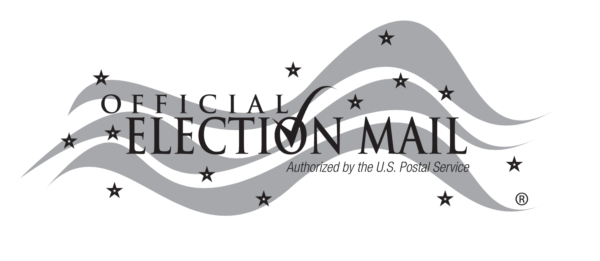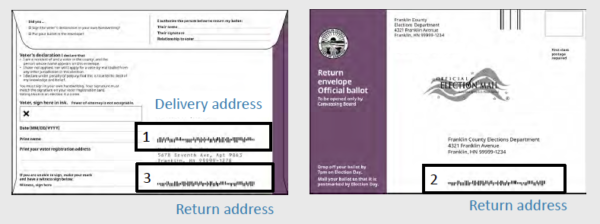Preparing to mail ballots
This is going to be a big year for voting from home, while we all stay at home. We sat down with the Election Mail team at the U.S. Postal Service for an updated review of vote-by-mail envelope designs.
During those meetings, we identified a few changes in the ballot layouts to better meet their service guidelines and ensure that election mail goes through.
Here are a few tips for getting postal requirements right. And four ways to collaborate with USPS and your local post office to make the 2020 elections a success.
Ballot layout updates for 2020
Use the Election Mail logo. It goes without saying that every piece of official election mail should proudly display the election mail logo. Voters recognize it. And it helps make the envelope more visible in the post office.

Use the right FIM in the right place. The FIM (that’s (Face Identification Mark) is the group of small vertical lines next to the stamp on the front of an envelope.
- No FIM on the outbound envelopes going to the voter
- Always use a FIM on the return envelopes going to the elections office. Use the FIM that matches the postage type.
Always use Intelligent Mail Barcodes. The Intelligent Mail Barcode (IMb) contains information that helps USPS – and you – track the mail. (You are using ballot tracking, right?!) The postal tracking record from the IMb can also be used to prove when a ballot was mailed in some states.
- Use an IMb for both the outgoing and return addresses.
- Include the correct election mail Service Type ID (STID) for each address.
- Put IMb in the right place on the envelope, so the scanners find it
- The voter IMb goes above the voter address on the back of the return envelope to show through a window. (#1)
- The elections address IMb goes in the lower right corner of the return envelope – on the front and the back. (#2 and 3)

Use colors to identify vote-by-mail envelopes. The colors in the vote by mail design system have meaning. There are colors for every type of envelope to help sort them accurately. We were asked not to use green because it conflicts with certified mail, so purple is the new green.
- Blue means “deliver to the voter’s address”
- Purple (or one of 8 alternatives) means “deliver to the elections office”
- Brown and tan are for overseas mail
- Yellow and pink are for other “envelope ballots” like provisionals
Use a return address. All envelopes need a return address, just in case. If the envelope as a color bar on the left, the return address goes in the upper-left corner of the white address area. Be sure there is no text or image in the top 5/8 inch of the color bar.
- The outbound return address is the address registered of your postage account.
- On the return envelope, use the elections office address, for two chances for the ballot to go back to the right place.
- For overseas and military mail put three lines for the voter to write in their address.
Work with the US Postal Service
Check your envelope with your regional Mail Design Analyst (MDA). Be sure you consult an MDA before you print. They will double-check your envelope design and give you a report with any changes they recommend.
To find an MDA, look up the Election Mail Coordinator nearest you on the US Postal Service site.
Help USPS engineering fine-tune election mail handling. They would like to collect as many versions of ballot envelopes as they can. As they told us, visual examination is the first look, but processing an actual ballot package is the best way to get ahead of any problems. Here’s what to do:
- Put together 25-50 samples of your ballot package with everything that goes inside, just as you will mail it: a ballot (can be from a previous election), inserts, and return envelopes.
- The USPS Engineering team will make sure that none of the samples get into the live mail stream, so there is no risk of anyone receiving test pieces. But just in case, mark everything sample or draft, and spoil the ballot.
- Use real addresses: the correct election office address for ballot return and residential address for the voter. Do not use a real name.
- Use the correct IMb for each address.
- Include any election management scan codes that will be printed on the envelopes
- Don’t put postage on the envelope.
Send your samples to:
Alfred Makonnen
USPS Engineering – SST
8403 Lee Highway
Merrifield, VA 22082-8101
Talk to your local post office. USPS isn’t all automation. Help all the mail sorters and carriers in your local post office know what your envelopes will look like and how they can help.
We’ve created a one-page ballot delivery guide for your local post office to help them recognize your envelopes and speed the ballots on their way. PDF preview sample. Powerpoint template file to adapt for your office.
Report any problems with ElectionMail.org. It’s the best way to make sure they get directly to the Election Mail unit, where they are read, taken seriously, and resolved as quickly as possible.
Resources
Download the updated templates from the Center for Civic Design. They are free to use.
- The new envelope designs can be downloaded from the workbook Designing vote at home envelopes and materials. There is a PDF preview and the full set of files in InDesign of bilingual and English layouts, ready to adapt to your jurisdiction.
- We also have a new tool kit of resources for scaling-up vote by mail. The envelopes are there, but so are many other resources for communicating with voters.
Find your way through the postal rules and regulations
- How to design VBM envelopes for USPS an overview of navigating USPS, rules, with best practices, and links to the official guides.
- 2020 State and Local Election Mail User’s Guide 632: The checklist on page 16 is especially helpful if you are handling the mail in house
And all the wonderful resources from our friends at the Elections Assistance Commission (and CISA) and the Vote at Home Institute
This was originally published in our Civic Designing newsletter. Subscribe on Mailchimp to get election design tips delivered to your mailbox.

